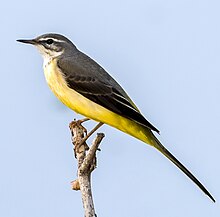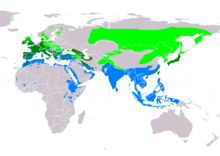灰鹡鸰
灰鹡鸰(学名:Motacilla cinerea)为鹡鸰科鹡鸰属下的一种鸟类。[2]这个物种主要在蒙古、中国大陆北部、朝鲜半岛、日本、俄罗斯繁殖;在中国大陆南部、台湾、菲律宾、中南半岛、印尼等地过冬。[3]
| 灰鹡鸰 | |
|---|---|

| |
| 印度海德拉巴的灰鹡鸰
| |
| 科学分类 | |
| 界: | 动物界 Animalia |
| 门: | 脊索动物门 Chordata |
| 纲: | 鸟纲 Aves |
| 目: | 雀形目 Passeriformes |
| 科: | 鹡鸰科 Motacillidae |
| 属: | 鹡鸰属 Motacilla |
| 种: | 灰鹡鸰 M. cinerea
|
| 双名法 | |
| Motacilla cinerea Tunstall, 1771
| |

| |
| 灰鹡鸰的分布范围 繁殖季 留鸟 非繁殖季
| |
| 异名 | |
|
Motacilla melanope | |
全长约18-19厘米。该物种看起来与黄鹡鸰有些相似,但其下腹部的黄色仅限于喉部和泄殖腔。繁殖期的雄鸟有黑色喉部,而雌鸟则有更多白色区域。其性别及冬夏间的羽色略有不同。[4]。
该物种分布广泛,几个种群在古北界的欧亚大陆繁殖,并迁徙至亚洲和非洲的热带地区。繁殖时,它们一般与流水相关,虽然它们可能会利用溪流附近的人造建筑来筑巢。非繁殖季节时,它们也可见于湖泊、海岸及其他水域栖地。相对于黄鹡鸰,这种鸟类更偏好山区活动。[5][3]与其他鹡鸰类似,它们经常摇动尾巴,飞行时呈波浪状,并且在飞行中经常发出尖锐的叫声。


分类与系统学
编辑灰鹡鸰的双名法Motacilla cinerea由马马杜克·唐斯塔尔于1771年在其著作《英国鸟类学》Ornithologia Britannica中首次介绍。[6][7] Motacilla是拉丁语中对灰鹡鸰的名称;尽管实际上是motare的指小词,意思是“移动”,但在中世纪时代引发了对cilla为“尾巴”的误解。种加词cinerea来自拉丁语cinis,意为“灰烬”,指“灰色”。[8]
该物种的亲缘关系尚未完全解决;它属于非洲鹡鸰之外的分支,这些物种在外部形态上令人困惑,mtDNA细胞色素b与NADH脱氢酶亚基2的序列数据无法稳健地解决其亲缘关系。虽然现有物种可能与黄头鹡鸰和一些西黄鹡鸰最为接近,但其确切的关系仍不明确。[9]
描述
编辑这种纤细的鹡鸰有狭窄的白色眉纹和断裂的眼环。上半身为灰色,与白色下腹部形成对比的黄色泄殖腔使其具有辨识度。繁殖期雄鸟有黑色喉部,边缘有白色的胡须状条纹。它们通常单独或成对在草地或浅水沼泽地觅食,也会使用水中的岩石,并经常栖息在树上。它们的叫声清脆尖锐,歌声由颤音组成。[11]
分布与栖地
编辑灰鹡鸰广泛分布于古北界地区,具有数个明显的种群。指名型(包括caspica,分布于伊朗、土耳其和高加索地区)来自西欧,包括不列颠群岛、斯堪的纳维亚和地中海地区。melanope亚种主要分布在东欧和中亚,主要沿着乌拉尔山脉、天山山脉和喜马拉雅山脉繁殖,与指名亚种之间的区分并不明显。[12] 它们在非洲和亚洲过冬。robusta亚种在亚洲东北部的西伯利亚繁殖,分布范围延伸至韩国和日本,这些亚种在东南亚过冬。岛屿型包括亚速尔群岛的patriciae、马德拉群岛的schmitzi及加那利群岛的canariensis。
它们有时会出现在阿拉斯加西部的岛屿上,但已知有时作为迷鸟出现在更南的加利福尼亚。[13]
行为与生态
编辑繁殖季节从四月到七月,巢筑在快速流动的溪流或河流旁的堤岸上,位于石头和树根之间。[11] 雄鸟在展示时会短暂飞向空中,然后慢慢下降,伴随着一系列快速的尖锐高音。[14] 在欧洲,巢穴通常筑于人工结构中的洞穴中。每窝产下3至6颗带有斑点的蛋,可能会多次繁殖,但后续每窝蛋的数量会逐渐减少。[15] 在爱尔兰,通常每窝产五颗蛋,繁殖成功率约为80%,蛋或雏鸟的捕食是主要的繁殖失败原因。[16] 加那利群岛的种群通常每窝蛋数较少,且繁殖季节没有较高纬度地区那么短且明显。[17] 孵卵期约两周,雏鸟在孵化后两周内羽化。野外的寿命最长可达8年。[18][19]
在其分布区的一些地区,河乌与灰鹡鸰共享相同的栖地,并且有一些异种哺育的纪录,即成鸟灰鹡鸰为褐河乌的雏鸟喂食。[20]
这些鸟类捕食各种水生无脊椎动物,包括成虫苍蝇、蜉蝣、甲虫、甲壳类和软体动物。[21] 它们在冬季经常沿着路边觅食,发出尖锐的chi-cheep叫声,飞向路边更远的地方,但飞行一段距离后又会折返至原地。[14]
在冬季,它们会成小群过夜。[22] 已知过冬的鸟类每年会回到同一地点,有时会选择一个小的城市花园。[14][23]
成鸟经常受到寄生虫蜱Ixodes ricinus的感染,这些蜱可以携带Borrelia,因此可能在广泛区域内传播莱姆病。[24] 此物种中也已知存在球虫病,如Isospora。[25]大杜鹃有时会对该物种进行巢寄生,[26] 而红隼有时会捕食它们。[27]
参考资料
编辑- ^ BirdLife International. Motacilla cinerea (amended version of 2016 assessment). The IUCN Red List of Threatened Species 2017: e.T22718392A111215843. [2024-05-27]. doi:10.2305/IUCN.UK.2016-3.RLTS.T22718392A111215843.en .
- ^ International Ornithologists' Union. Gill, Frank; Donsker, David; Rasmussen, Pamela , 编. IOC World Bird List 14.1. [2023-12-20] (英语).
- ^ 3.0 3.1 灰鶺鴒. 阳明山国家公园万维网-中文网. [2024-05-27]. (原始内容存档于2024-05-27) (中文(台湾)).
- ^ 刘小如; 丁宗苏; 方伟宏; 林文宏; 蔡牧起; 颜重威. 台灣鳥類誌第二版(下). 台湾: 行政院农业委员会林务局. 2012-12-01: 526—528 [2023-08-18]. ISBN 9789860339277. (原始内容存档于2020-05-20) (中文(台湾)).
- ^ 灰鶺鴒. 卫生福利部国家中医药研究所. [2024-05-27]. (原始内容存档于2024-05-27).
- ^ Schodde, R.; Bock, W.J. The valid name for the Grey Wagtail. Bulletin of the British Ornithologists' Club. 2008, 128 (2): 132–133.
- ^ Tunstall, Marmaduke. Newton, Alfred , 编. Tunstall's Ornithologia britannica. London: J. Akerman. 1880: 2 [1771] (拉丁语). A photo-lithographic reproduction of the original publication.
- ^ Jobling, James A. The Helm Dictionary of Scientific Bird Names. London, United Kingdom: Christopher Helm. 2010: 107, 261. ISBN 978-1-4081-2501-4.
- ^ Voelker, Gary. Systematics and historical biogeography of wagtails: Dispersal versus vicariance revisited. Condor. 2002, 104 (4): 725–739. S2CID 85844839. doi:10.1650/0010-5422(2002)104[0725:SAHBOW]2.0.CO;2 .
- ^ Gill, Frank; Donsker, David; Rasmussen, Pamela (编). Waxbills, parrotfinches, munias, whydahs, Olive Warbler, accentors, pipits. IOC World Bird List Version 11.1. International Ornithologists' Union. January 2021 [3 June 2021].
- ^ 11.0 11.1 Rasmussen PC; Anderton, JC. Birds of South Asia: The Ripley Guide. Volume 2. Smithsonian Institution & Lynx Edicions. 2005: 317.
- ^ Hume, AO. The nests and eggs of Indian Birds. Volume 2.. R H Porter, London. 1890: 207.
- ^ Checklist of Alaska birds (PDF) 15th. University of Alaska, Fairbanks. 2009 [30 October 2009].
- ^ 14.0 14.1 14.2 Ali, S; Ripley, S D. Handbook of the birds of India and Pakistan. Volume 9 2nd. 1998: 290–292.
- ^ Klemp S. Effects of parental effort on second brood, moult and survival in the Grey Wagtail Motacilla cinerea. Ardea. 2000, 88 (1): 91–98.
- ^ Smiddy, P.; O'Halloran, J. Breeding biology of the Grey Wagtail Motacilla cinerea in southwest Ireland. Bird Study. 1998, 45 (3): 331–336. doi:10.1080/00063659809461104.
- ^ Rodríguez B.; Rodríguez A. Breeding biology of Grey Wagtail Motacilla cinerea canariensis on Tenerife, Canary Islands (PDF). Acta Ornithol. 2007, 42 (2): 195–199 [2009-10-28]. doi:10.3161/068.042.0203 . (原始内容 (PDF)存档于2016-03-04).
- ^ Robinson, R.A. BirdFacts: profiles of birds occurring in Britain & Ireland. BTO Research. 2005 [28 October 2009].
- ^ Jørgensen OH. Migration and Aspects of Population Dynamics in the Grey Wagtail Motacilla cinerea. Ornis Scandinavica. 1976, 7 (1): 13–20. JSTOR 3676170. doi:10.2307/3676170.
- ^ Yoerg, SI; O'Halloran, J. Dipper Nestlings Fed by a Gray Wagtail (PDF). Auk. 1991, 108 (2): 427–429.
- ^ Santamarina, Jesus. The Grey Wagtall (Motacilla cinerea) diet in the Ulla river basin, Galicia. NW Spain (PDF). Ardeola. 1989, 37 (1): 97–101 (西班牙语).
- ^ Neelakantan, KK. Roosting of the Grey Wagtail [Motacilla caspica (Gmelin)] in the Thekkady Wild Life Sanctuary. J. Bombay Nat. Hist. Soc. 1964, 61 (3): 691–692.
- ^ Nickell, Walter P. Return of Northern Migrants to Tropical Winter Quarters and Banded Birds Recovered in the United States. Bird-Banding. 1968, 39 (2): 107–116. JSTOR 4511469. doi:10.2307/4511469.
- ^ Dubska, Lenka; Ivan Literak; Elena Kocianova; Veronika Taragelova; Oldrich Sychra. Differential Role of Passerine Birds in Distribution of Borrelia Spirochetes, Based on Data from Ticks Collected from Birds during the Postbreeding Migration Period in Central Europe. Applied and Environmental Microbiology. 2009, 75 (3): 596–602. Bibcode:2009ApEnM..75..596D. PMC 2632145 . PMID 19060160. doi:10.1128/AEM.01674-08.
- ^ Svobodova, M. Isospora, Caryospora and Eimeria (Apicomplexa: Passeriform Birds from Czech Republic (PDF). Acta Protozoologica. 1994, 33: 101–108.
- ^ Adamík P.; Hušek J.; Cepák J. Rapid decline of Common Cuckoo Cuculus canorus parasitism in Red-backed Shrikes Lanius collurio (PDF). Ardea. 2009, 97 (1): 17–22 [2013-03-29]. S2CID 86228074. doi:10.5253/078.097.0103. (原始内容 (PDF)存档于2016-03-04).
- ^ Costantini, David; Casagrande, Stefania; Di Lieto, Giuseppe; Fanfani, Alberto; Dell'Omo, Giacomo. Consistent differences in feeding habits between neighbouring breeding kestrels (PDF). Behaviour. 2005, 142 (9–10): 1403–1415. doi:10.1163/156853905774539409. (原始内容 (PDF)存档于2007-07-10).
外部链接
编辑| 这是一篇与雀形目相关的小作品。您可以通过编辑或修订扩充其内容。 |
